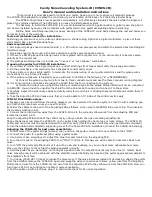
26 Installation
●
If one or more voltages are too low (by more than 5%), then make sure you have the correct
model. For example, a WNC-3Y-208-MB expects line-to-neutral voltages of 120 Vac and can
measure up to about 150 Vac. If you apply 208 Vac line-to-neutral, the WattNode meter will
read a voltage in the 150 Vac to 180 Vac range.
●
If any voltages read high, then check your wiring. If the wiring is correct, contact support.
●
If the voltages are close to the measured (or expected) values, continue with the next step.
Power
Next, check the measured power for each active phase (
PowerA
,
PowerB
,
PowerC
). If possible,
estimate or measure the actual power. Also, make sure the load you are measuring is currently
on.
●
If one or more active phases are reporting zero power, then the problem is probably one of
the following:
○
There is no active power (the load is off) or the power is too low to measure (generally
less than 1/1000th of full-scale).
○
CT wires are not securely connected.
○
The CT or its wires are damaged.
○
There is strong electrical interference, as might occur if the meter is in very close proxim-
ity to a variable speed drive (also called variable frequency drive or inverter).
○
The meter is not working correctly: try swapping it with a replacement WattNode meter.
●
If one or more active phases are reporting negative power:
○
The current transformer has been installed backward on the wire being measured. CTs
are marked with either an arrow or a label saying “This side toward source”. If the arrow
or label are not oriented toward the source of power (generally the panel or breaker), then
the measured current will be inverted and the power negative. This can be fixed either by
flipping the CT or by swapping the white and black wires where they enter the meter.
○
The current transformer white and black wires have been swapped where they enter the
WattNode meter (at the black screw terminal block).
○
The line voltage phases (green screw terminals) are not matched up with the current
phases (black screw terminals). For example, the phase A CT is around the phase B wire.
○
This may be normal if you are measuring in an environment were power may be con-
sumed or generated, such as a house with PV panels.
●
If one or more phases are reporting low or high power:
○
Make sure the
CtAmps
configuration is set correctly for your current transformers.
○
The current transformers may have a rated current too high or too low for your applica-
tion. CTs should be used between 1% and 100% of their rated current for best results.
They generally work with reduced accuracy as low as 0.5% to 0.1% of rated current.
○
The CTs may not be installed properly. Check for: CTs touching each other or pre-
existing CTs; CT opening too large for the conductor being measured.
○
The voltage phases (green screw terminal block) are not matched up with the current
phases (black screw terminal block). The easiest way to determine this is to skip ahead
to the next troubleshooting section:
Power Factor and Reactive Power
○
Interference from a variable frequency or variable speed drive: VFD, VSD, inverter, or the
like. Generally, these drives should not interfere with the WattNode meter, but if they are
in very close proximity, or if the CT leads are long, interference can occur. Try moving the
WattNode meter at least three feet (one meter) away from any VFDs. Use short CT leads
if possible.
NEVER
install the meter downstream of a VFD: the varying line frequency and
extreme noise will cause problems!
















































